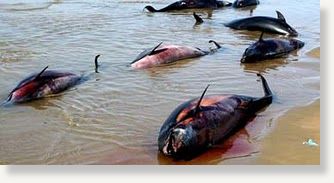Puducherry: Sixteen long-nosed dolphins were washed ashore dead at three places along the Puducherry coast on Monday. It has raised concern among environmentalists as it is the 20th instance in 16 months of protected marine mammals being washed ashore dead or alive.
On an average, about 250 dolphins are washed shore dead or alive every year, said Dr R S Lal Mohan, retired principal scientist of the Central Marine Fisheries Research Institute (
CMFRI).
A group of fishermen in Pudukuppam in the Union territory spotted five dead dolphins on the shore on Monday morning and alerted the forest and fisheries department officials. A few hours later, fishermen from neighbouring hamlets also informed them about 11 more dead dolphins found at two other places.
A team of officials led by deputy conservator of forests Dr A Anil Kumar visited the hamlets and inspected the dead mammals. Veterinary doctors conducted postmortem examinations and buried 15 dolphins. One carcass was sent to Rajiv Gandhi College of Veterinary Sciences here for detailed analysis.
The dolphins measured between two-and-a-half feet and five feet. Ten were females of which two were found to be pregnant.
Dolphins are marine mammals that inhabit relatively less deep regions of oceans. They are mainly carnivorous and feed on fish. They are also highly social and move in groups called pods. "All the dead dolphins washed ashore probably belonged a pod and none of them bore any external injuries," said Kumar. "Veterinary experts have conducted postmortem examinations."
According to him, it was a phenomenon of mass stranding' which is common among dolphins. "It's a phenomenon of mass stranding in which an entire group tends to drift to shallow parts of the ocean and fail to get back to their original trail," he said.
Experts in the veterinary college here will undertake further histopathological studies to ascertain the cause of death. The forest department will also seek the opinion of the scientists at CMFRI in Chennai. "Our analysis revealed that the mammals did not suffer from major diseases and only a detailed analysis will throw more light on the cause of death," Kumar said.
Lal Mohan, a member of the Cetacean Specialist Group, an international organisation, said mass stranding could be a reason for the deaths, but he also listed out other possible reasons. "Gill nets, high levels of pollution and radars sometimes spell doom for endangered marine species. Similarly, these mammals, particularly dolphins, follow the magnetic line of the earth and radar interference will affect their original trail, leading them to shallow waters," he said.

It would make more sense to take two more carcasses for a histopathological examination in another lab then compare results.
250 dolphins a year wash up on those shores. Everything living dies but when it is a mass there should always be concern for a cause.